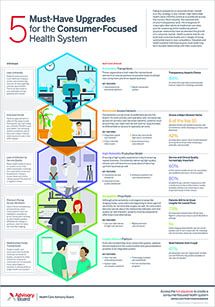Editor's note: This popular story from the Daily Briefing's archives was republished on Jan 17, 2019.
The health care system's shift from paper to electronic health records presented providers with a new dilemma: How to maintain accurate and complete medical documentation without taking time away from face-to-face patient interactions?
Digital health cheat sheets: Understand interoperability, EHR optimization, and more
At the University of Texas MD Anderson Cancer Center, hospital leaders took a unique approach and got patients more involved in the data entry process—a move that reduced provider data entry time and produced cost savings, hospital leaders write in NEJM Catalyst.
MD Anderson's new EHR system
Faced with mounting research showing physicians spend up half of their day on data entry, the Perioperative Anesthesia Assessment Center at MD Anderson leadership team sought to find an alternative solution.
The team hypothesized that the most effective and least costly solution was to "capitalize on patients' vested interest in their own health care." They explain, when patients enter their own medical history information into an EHR, providers have access to a patient's medical history beforehand, which "can assist providers in planning and in directing patients to the appropriate patient care pathways within their institution."
To test that theory, they developed and in March 2016 launched a new EHR system that featured a 40-question electronic survey. The survey was designed with input from both patients and providers across the center and was intended to eliminate redundancy in questions asked during a patient's visit. Clinicians worked with IT specialists to ensure that the new EHR was not "an electronic version" of the clinics' original, inefficient data entry process.
To support physician engagement in the process, physicians took courses that the EHR vendor offered to learn more about the EHR system's capabilities.
Providers spend less time on data entry
Since the implementation of the new MD Anderson EHR system, 34% of patients filled out the questionnaire at least one day before their appointment, and providers were able to reduce their data-entry time by 10 minutes, according to the MD Anderson team.
The leadership team said they were "disappointed" that more patients didn't fill out the questionnaire ahead of time. The team adds that the new system "can save patients and providers time and frustration, can allow for advanced care planning, and can help to ensure transparency of patient information."
According to the MD Anderson leadership team, provider input was critical to the development phase of the EHR system and questionnaire—especially regarding the contents and structure of the 40 questions. Common structure for documentation was also key, the MD Anderson team writes. The team adds, "[S]tructured notes facilitated the flow of data and information from various sources...so that it could be reflected in many areas of the EHR."
5 takeaways for boosting patient participation in EHRs—and what it'll do for your health system
From their experience, the MD Anderson team offers five "take-home points" about boosting patient participation in EHR data entry:
- Developing a new EHR requires active participation from all team players;
- Identify the specific data entry points that are expected to benefit the most from being entered by patients;
- Engage patients in data entry to save time, support advance care planning, and promote transparency of patient information within the institution;
- Interoperability could significantly reduce the burden on patients of filling out long, redundant forms; and
- Patients might be more likely to answer questions before their appointments if health care organizations take efforts to show patients the benefits their efforts will afford.
"[H]ealth care delivery needs to be more interactive," the MD Anderson team writes. "Time is a commodity that both patients and providers can appreciate. Engaging patients to actively participate in helping to enter their medical information is one way for both groups to realize this benefit" (Katy French et al., NEJM Catalyst, 9/24).
Cheat sheets: Understand interoperability, EHR optimization, and more
Download our cheat sheets so you can keep track of the fast-changing technologies and capitalize on opportunities for IT-powered innovation. Check out our guides for these topics and more:
Don't miss out on the latest Advisory Board insights
Create your free account to access 1 resource, including the latest research and webinars.
Want access without creating an account?
You have 1 free members-only resource remaining this month.
1 free members-only resources remaining
1 free members-only resources remaining
You've reached your limit of free insights
Become a member to access all of Advisory Board's resources, events, and experts
Never miss out on the latest innovative health care content tailored to you.
Benefits include:
You've reached your limit of free insights
Become a member to access all of Advisory Board's resources, events, and experts
Never miss out on the latest innovative health care content tailored to you.
Benefits include:
This content is available through your Curated Research partnership with Advisory Board. Click on ‘view this resource’ to read the full piece
Email ask@advisory.com to learn more
Click on ‘Become a Member’ to learn about the benefits of a Full-Access partnership with Advisory Board
Never miss out on the latest innovative health care content tailored to you.

